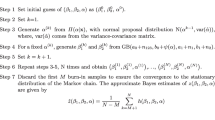Abstract
Competing risks data with missing cause of failure are analyzed under the accelerated failure time model which is a popular semiparametric linear model in survival analysis. The missing mechanism is assumed to be missing at random. The inverse probability weighted and double robust techniques are used to modify the rank-based estimating functions for competing risks data with complete observations on cause of failure. Proper optimization technique is utilized to obtain the desired estimators. The proposed algorithm overcomes the difficulty in solving the rank estimating equations with discontinuous estimating functions. The asymptotic properties of the proposed estimators are established. To implement the related inferences, a nonparametric bootstrap approach as well as a score test is developed. Simulation studies are carried out to assess the finite sample performance of the proposed method and validate the theoretical findings. The new estimating procedure is illustrated with the data from a bone marrow transplant study.
Similar content being viewed by others

References
Cox, D. R., Oakes, D. (1984). Analysis of survival data. New York: Chapman and Hall.
Gao, G., Tsiatis, A. A. (2005). Semiparametric estimators for the regression coefficients in the linear transformation competing risks model with missing cause of failure. Biometrika, 92, 875–891.
Gijbels, I., Lin, D. Y., Ying, Z. (2007). Non- and semi-parametric analysis of failure time data with missing failure indicators. IMS Lecture Notes—Monograph Series, Complex Datasets and Inverse Problems: Tomography, Networks and Beyond, 54, 203–223.
Goetghebeur, E., Ryan, L. (1995). Analysis of competing risks survival data when some failure types are missing. Biometrika, 82, 821–834.
Horvitz, D. G., Thompson, D. J. (1952). A generalization of sampling without replacement from a finite universe. Journal of the American Statistical Association, 47, 663–685.
Hyun, S., Lee, J., Sun, Y. (2012). Proportional hazards model for competing risks data with missing cause of failure. Journal of Statistical Planning and Inference, 142, 1767–1779.
Jin, Z., Lin, D. Y., Wei, L. J., Ying, Z. (2003). Rank-based inference for the accelerated failure time model. Biometrika, 90, 341–353.
Kalbfleisch, J. D., Prentice, R. D. (2002). The Statistical Analysis of Failure Time Data. New York: Wiley.
Lee, S., Lewbel, A. (2009). Nonparametric identification of accelerated failure time competing risks models. Working paper, University College London and Boston College.
Lin, D. Y., Wei, L. J., Ying, Z. (1998). Accelerated failure time models for counting processes. Biometrika, 85, 605–618.
Liu, C., Wang, Q. (2010). Semiparametric estimation for regression coefficients in the Cox model with failure indicators missing at random. Statistica Sinica, 20, 1125–1142.
Lu, K., Tsiatis, A. A. (2001). Multiple imputation methods for estimating regression coefficients in the competing risks model with missing cause of failure. Biometrics, 57, 1191–1197.
Lu, W., Liang, Y. (2008). Analysis of competing risks data with missing cause of failure under additive hazards model. Statistica Sinica, 18, 219–234.
McKeague, I. W., Subramanian, S. (1998). Product-limit estimators and Cox regression with missing censoring information. Scandinavian Journal of Statistics, 25, 589–601.
Prentice, R. L. (1978). Linear rank tests with right censored data. Biometrika, 65, 167–179.
Prentice, R. L., Kalbfleisch, J. D. (1978). The analysis of failure times in the presence of competing risks. Biometrics, 34, 541–554.
Robins, J. M., Rotnitzky, A., Zhao, L. P. (1994). Estimation of regression coefficients when some regressors are not always observed. Journal of the American Statistical Association, 89, 846–866.
Sierra, J., Perez, W., Rozman, W., Carreras, C., Klein, J., Rizzo, J., et al. (2002). Bone marrow transplantation from HLA-identical siblings as treatment for myelodysplasia. Blood, 100, 1997–2004.
Song, X., Sun, L., Mu, X., Dinse, G. E. (2010). Additive hazards regression with censoring indicators missing at random. The Canadian Journal of Statistics, 38, 333–351.
Tsiatis, A. A. (1990). Estimating regression parameters using linear rank tests for censored data. The Annals of Statistics, 18, 354–372.
Wang, Q., Dinse, G. E. (2011). Linear regression analysis of survival data with missing censoring indicators. Lifetime Data Analysis, 17, 256–279.
Ying, Z. (1993). A large sample study of rank estimation for censored regression data. The Annals of Statistics, 21, 76–99.
Zhou, X., Sun, L. (2003). Additive hazards regression with missing censoring information. Statistica Sinica, 13, 1237–1257.
Acknowledgments
The authors thank the Associate Editor and two referees whose insightful comments and suggestions have resulted in a great deal of improvement. The research of Ming Zheng was supported by the National Natural Science Foundation of China (11271081). The research of Wen Yu was supported by the National Natural Science Foundation of China (11101091).
Author information
Authors and Affiliations
Corresponding author
About this article
Cite this article
Zheng, M., Lin, R. & Yu, W. Competing risks data analysis under the accelerated failure time model with missing cause of failure. Ann Inst Stat Math 68, 855–876 (2016). https://doi.org/10.1007/s10463-015-0516-y
Received:
Revised:
Published:
Issue Date:
DOI: https://doi.org/10.1007/s10463-015-0516-y



